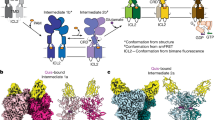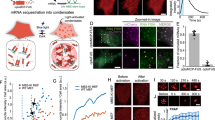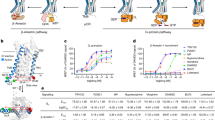Abstract
The light-gated cation channel channelrhodopsin-2 (ChR2) has rapidly become an important tool in neuroscience, and its use is being considered in therapeutic interventions. Although wild-type and known variant ChR2s are able to drive light-activated spike trains, their use in potential clinical applications is limited by either low light sensitivity or slow channel kinetics. We present a new variant, calcium translocating channelrhodopsin (CatCh), which mediates an accelerated response time and a voltage response that is ∼70-fold more light sensitive than that of wild-type ChR2. CatCh's superior properties stem from its enhanced Ca2+ permeability. An increase in [Ca2+]i elevates the internal surface potential, facilitating activation of voltage-gated Na+ channels and indirectly increasing light sensitivity. Repolarization following light-stimulation is markedly accelerated by Ca2+-dependent BK channel activation. Our results demonstrate a previously unknown principle: shifting permeability from monovalent to divalent cations to increase sensitivity without compromising fast kinetics of neuronal activation. This paves the way for clinical use of light-gated channels.
This is a preview of subscription content, access via your institution
Access options
Subscribe to this journal
Receive 12 print issues and online access
$209.00 per year
only $17.42 per issue
Buy this article
- Purchase on Springer Link
- Instant access to full article PDF
Prices may be subject to local taxes which are calculated during checkout




Similar content being viewed by others
References
Nagel, G. et al. Channelrhodopsin-2, a directly light-gated cation-selective membrane channel. Proc. Natl. Acad. Sci. USA 100, 13940–13945 (2003).
Nagel, G. et al. Light activation of channelrhodopsin-2 in excitable cells of Caenorhabditis elegans triggers rapid behavioral responses. Curr. Biol. 15, 2279–2284 (2005).
Boyden, E.S., Zhang, F., Bamberg, E., Nagel, G. & Deisseroth, K. Millisecond-timescale, genetically targeted optical control of neural activity. Nat. Neurosci. 8, 1263–1268 (2005).
Zhang, F. et al. Multimodal fast optical interrogation of neural circuitry. Nature 446, 633–639 (2007).
Bamann, C., Gueta, R., Kleinlogel, S., Nagel, G. & Bamberg, E. Structural guidance of the photocycle of channelrhodopsin-2 by an interhelical hydrogen bond. Biochemistry 49, 267–278 (2010).
Berndt, A., Yizhar, O., Gunaydin, L., Hegemann, P. & Deisseroth, K. Bi-stable neural state switches. Nat. Neurosci. 12, 229–234 (2009).
Lin, J.Y., Lin, M., Steinbach, P. & Tsien, R. Characterization of engineered channelrhodopsin variants with improved properties and kinetics. Biophys. J. 96, 1803–1814 (2009).
Lagali, P.S. et al. Light-activated channels targeted to ON bipolar cells restore visual function in retinal degeneration. Nat. Neurosci. 11, 667–675 (2008).
Bi, A. et al. Ectopic expression of a microbial-type rhodopsin restores visual responses in mice with photoreceptor degeneration. Neuron 50, 23–33 (2006).
Frankenhaeuser, B. & Hodgkin, A. The action of calcium on the electrical properties of squid axons. J. Physiol. (Lond.) 137, 218–244 (1957).
Hille, B. Ion Channels of Excitable Membranes 3rd edn., 649–662 (Sinauer, Sunderland, Massachusetts, USA, 2001).
Gunaydin, L.A. et al. Ultrafast optogenetic control. Nat. Neurosci. 13, 387–392 (2010).
Bamann, C., Kirsch, T., Nagel, G. & Bamberg, E. Spectral characteristics of the photocycle of channelrhodopsin-2 and its implication for channel function. J. Mol. Biol. 375, 686–694 (2008).
Feldbauer, K. et al. Channelrhodopsin-2 is a leaky proton pump. Proc. Natl. Acad. Sci. USA 106, 12317–12322 (2009).
Caldwell, J. et al. Increases in intracellular calcium triggered by channelrhodopsin-2 potentiate the response of metabotropic glutamate receptor mGluR7. J. Biol. Chem. 283, 24300–24307 (2008).
Weber, W. Ion currents in Xenopus laevis oocytes: state of the art. Biochim. Biophys. Acta 1421, 213–233 (1999).
Thyagarajan, S. et al. Visual function in mice with photoreceptor degeneration and transgenic expression of channelrhodopsin 2 in ganglion cells. J. Neurosci. 30, 8745–8758 (2010).
Hille, B., Woodhull, B. & Shapiro, B. Negative surface charge near sodium channels of nerve: divalent ions, monovalent ions, and pH. Phil. Trans. R. Soc. Lond. B 270, 301–318 (1975).
Muller, R.U. & Finkelstein, A. The effect of surface charge on the voltage-dependent conductance induced in thin lipid membranes by monazomycin. J. Gen. Physiol. 60, 285–306 (1972).
Faber, E.S. & Sah, P. Calcium-activated potassium-channels: multiple contributions to neuronal function. Neuroscientist 9, 181–194 (2003).
Joh, N.H., Oberai, A., Yang, D., Whitelegge, J. & Bowie, J. Similar energetic contributions of packing in the core of membrane and water-soluble proteins. J. Am. Chem. Soc. 131, 10846–10847 (2009).
Subramaniam, S., Faruqi, A., Oesterhelt, D. & Henderson, R. Electron diffraction studies of light-induced conformational changes in the Leu-93→Ala bacteriorhodopsin mutant. Proc. Natl. Acad. Sci. USA 94, 1767–1772 (1997).
Subramaniam, S., Greenhalgh, D., Rath, P., Rothschild, K. & Khorana, H. Replacement of leucine-93 by alanine or threonine slows down the decay of the N and O intermediates in the photocycle of bacteriorhodopsin: implications for proton uptake and 13-cis-retinal all-trans-retinal reisomerization. Proc. Natl. Acad. Sci. USA 88, 6873–6877 (1991).
Nack, M. et al. The DC gate in Channelrhodopsin-2: crucial hydrogen bonding interaction between C128 and D156. Photochem. Photobiol. Sci. 9, 194–198 (2010).
Cady, C., Evans, M.S. & Brewer, G.J. Age-related differences in NMDA responses in cultured rat hippocampal neurons. Brain Res. 921, 1–11 (2001).
Busskamp, V. et al. Genetic reactivation of cone photoreceptors restores visual responses in retinitis pigmentosa. Science 329, 413–417 (2010).
Humphrey, W., Dalke, A. & Schulten, K. VMD: visual molecular dynamics. J. Mol. Graph. 14, 33–38 (1996).
Lorenz, C., Pusch, M. & Jentsch, T. Heteromultimeric ClC chloride channels with novel properties. Proc. Natl. Acad. Sci. USA 93, 13362–13366 (1996).
Allocca, M. et al. Novel adeno-associated virus serotypes efficiently transduce murine photoreceptors. J. Virol. 81, 11372–11380 (2007).
de Felipe, P. et al. E unum pluribus: multiple proteins from a self-processing polyprotein. Trends Biotechnol. 24, 68–75 (2006).
Acknowledgements
We would like to thank I. Bartnik for the preparation of the hippocampal neuron cultures, S. O'Shea for the help with the calcium imaging experiments, V. Busskamp for the support in recombinant adeno-associated virus construction, H. Biehl for excellent technical assistance, and K. Hartung, H. Spors, U. Terpitz and M. van Wyk for helpful discussions. The work was supported by grants from the Deutsche Forschungsgemeinschaft Sonderforschungsbereich 807, Centre of Excellence Frankfurt Macromolecular Complexes and the Federal Ministry of Education and Research of Germany (01GQ0815) to E.B., and by the Max Planck Society.
Author information
Authors and Affiliations
Contributions
S.K., R.E.D., P.G.W. and E.B. conceived the experiments. S.K., K.F., H.F. and C.B. carried out the experiments. S.K., C.B. and K.F. performed the data analysis. S.K., C.B. and E.B. wrote the manuscript.
Corresponding author
Ethics declarations
Competing interests
The authors declare no competing financial interests.
Supplementary information
Supplementary Text and Figures
Supplementary Figures 1–3, Supplementary Note and Supplementary Discussion (PDF 251 kb)
Rights and permissions
About this article
Cite this article
Kleinlogel, S., Feldbauer, K., Dempski, R. et al. Ultra light-sensitive and fast neuronal activation with the Ca2+-permeable channelrhodopsin CatCh. Nat Neurosci 14, 513–518 (2011). https://doi.org/10.1038/nn.2776
Received:
Accepted:
Published:
Issue Date:
DOI: https://doi.org/10.1038/nn.2776
This article is cited by
-
A micro-LED array based platform for spatio-temporal optogenetic control of various cardiac models
Scientific Reports (2023)
-
Calcium-permeable channelrhodopsins for the photocontrol of calcium signalling
Nature Communications (2022)
-
Chronic nicotine increases midbrain dopamine neuron activity and biases individual strategies towards reduced exploration in mice
Nature Communications (2021)
-
A neuroanatomical basis for electroacupuncture to drive the vagal–adrenal axis
Nature (2021)



